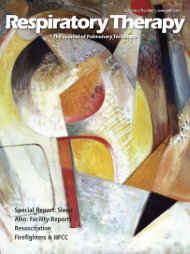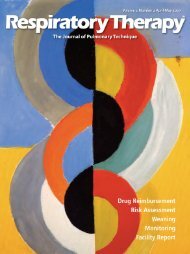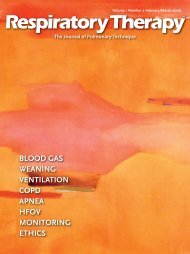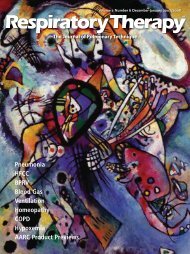RT 02-03 JJ07 main web - Respiratory Therapy Website
RT 02-03 JJ07 main web - Respiratory Therapy Website
RT 02-03 JJ07 main web - Respiratory Therapy Website
You also want an ePaper? Increase the reach of your titles
YUMPU automatically turns print PDFs into web optimized ePapers that Google loves.
Table 2: Values of V,NEP 0.5 and V,NEP 1 at two different NEP levels in seated and supine position.<br />
SEATED SUPINE<br />
NEP -5 cmH 2 O -7 cmH 2 O -5 cmH 2 O -7 cmH 2 O<br />
performed. Then, one-way ANOVA was used to compare data<br />
among groups both in seated and supine position and at<br />
different negative pressure and finally multiple comparisons,<br />
corrected by the Bonferroni method, were performed between<br />
groups, if allowed by the F-value. To assess differences in<br />
V,NEP 0.5 and V,NEP 1 within groups between seated and supine<br />
posture and different levels of negative pressure a paired<br />
Student’s test was applied. Correlations between quantitative<br />
variables were performed using the Spearman’s rank-order test.<br />
A p value less than 0.05 was considered statistically significant.<br />
The receiver-operating characteristic curves (ROC) were<br />
performed to assess sensitivity and specificity of V,NEP 0.5 and<br />
V,NEP 1 obtained with different levels of NEP in both positions to<br />
get optimal cut-offs.<br />
Results: The anthropometric and functional characteristics of<br />
the subjects are shown in Table 1. Snorers and OSAH patients<br />
were well matched, but patients with severe OSAH were older<br />
and had greater BMI than controls (p < 0.01). No correlation,<br />
however, was present between V,NEP 0.5 and V,NEP 1 and BMI in<br />
snorers and OSAH patients. None of the subjects had significant<br />
restrictive or obstructive ventilatory defect and exhibited tidal<br />
intrathoracic EFL in either position during NEP application.<br />
The values (mean ± SD) of V,NEP 0.5 and V,NEP 1, in both<br />
positions and NEP levels, are shown in Table 2. The individual<br />
V,NEP 0.5 data in each group are shown in Fig. 2. Similar values of<br />
V,NEP 0.5 and V,NEP 1 were obtained in subjects with mild-tomoderate<br />
and with severe OSAH in all experimental conditions<br />
and were treated as a single group for comparative analysis.<br />
ΔV,NEP 0.5 and ΔV,NEP 1 reflected exactly what was shown by<br />
V,NEP 0.5 and V,NEP 1with no additional advantage in order to<br />
distinguish the different groups. Therefore, we did not consider<br />
these time-consuming indices for subsequent analysis.<br />
Within each group V,NEP 0.5 and V,NEP 1were significantly higher<br />
with NEP -7 cmH 2O than with NEP -5 cmH 2O in both positions,<br />
and with the same negative pressure higher in the seated<br />
V,NEP 0.5<br />
Controls 559 ± 98 655 ± 113 492 ± 69 571 ± 96<br />
Snorers 457 ± 150 520 ± 147 427 ± 101 430 ± 134<br />
OSAH 363 ± 123* 419 ± 132** 340 ± 88** # 379 ± 113**<br />
OSAH, m 4<strong>02</strong> ± 129 428 ± 157 353 ± 1<strong>03</strong> 387 ± 108<br />
OSAH, s 332 ± 112 410 ± 112 329 ± 73 372 ± 119<br />
V,NEP 1<br />
Controls 1<strong>03</strong>6 ± 134 1128 ± 158 832 ± 95 920 ± 136<br />
Snorers 864 ± 246 930 ± 274 737 ± 194 755 ± 224<br />
OSAH 708 ± 189* 781 ± 210* 628 ± 136* 669 ± 177*<br />
OSAH, m 732 ± 2<strong>02</strong> 766 ± 230 625 ± 159 666 ± 178<br />
OSAH, s 688 ± 182 792 ± 199 629 ± 120 671 ± 180<br />
OSAH = obstructive sleep apnea-hypopnea; m = mild; s = severe; data are mean ± SD; * p < 0.01 vs Controls; ** p < 0.001 vs Controls; # p < 0.01<br />
vs Snorers<br />
position than in the supine one (p < 0.05 for controls, p < 0.01<br />
for snorers and patients with OSAH).<br />
The patients with OSAH consistently exhibited values of<br />
V,NEP 0.5 and V,NEP 1 much lower than control subjects (p <<br />
0.001), but had values of V,NEP 0.5 significantly reduced as<br />
compared to snorers only with NEP -5 cmH 2O in the supine<br />
position (p < 0.01) (Fig. 2).<br />
The receiver operating characteristic (ROC) curves performed<br />
for V,NEP 0.5 and V,NEP 1 in both positions at the two different<br />
levels of NEP showed similar areas with the highest value for<br />
V,NEP 0.5 in the supine position using NEP of -5 cmH 2O (Fig. 3).<br />
Under these conditions, the optimal cut-off V,NEP 0.5 value of 393<br />
ml had a sensitivity of 76% and a specificity of 74% to detect the<br />
presence of OSAH with a likelihood ratio for positive results of<br />
2.9. Accordingly, its positive and negative predictive value was<br />
84% and 64%, respectively.<br />
No significant correlation between V,NEP 0.5 (in the supine<br />
position with NEP level of -5 cmH 2O) and AHI was observed in<br />
patients with OSAH (r s = -0.31, r s 2 = 0.10; 95%IC = -0.59 – 0.04).<br />
However, taking into account only the patients with severe<br />
OSAH (AHI ≥ 30), a significant inverse correlation was found<br />
between V,NEP 0.5 and AHI (p < 0.05; r s = -0.46, r s 2 = 0.21; 95%IC =<br />
-0.76 – -0.01) (Fig. 4).<br />
Discussion<br />
The present study indicates that during wakefulness OSAH<br />
patients when compared to snorers and controls have greater<br />
collapsibility of the upper airways which can be easily assessed<br />
looking at the early expiratory flow dynamics after NEP<br />
application during tidal breathing and properly measured as<br />
V,NEP 0.5 and V,NEP 1. Such measurements, however, are unable<br />
to distinguish on an individual basis apneic from non-apneic<br />
snorers because of the overlapping of the V,NEP 0.5 and V,NEP 1<br />
values between these groups of subjects. Nevertheless, our<br />
results provide support to the idea that a high degree of the<br />
upper airway collapsibility promotes OSAH, even if OSAH may<br />
<strong>Respiratory</strong> <strong>Therapy</strong> Vol. 2 No. 3 � June-July 2007 67











